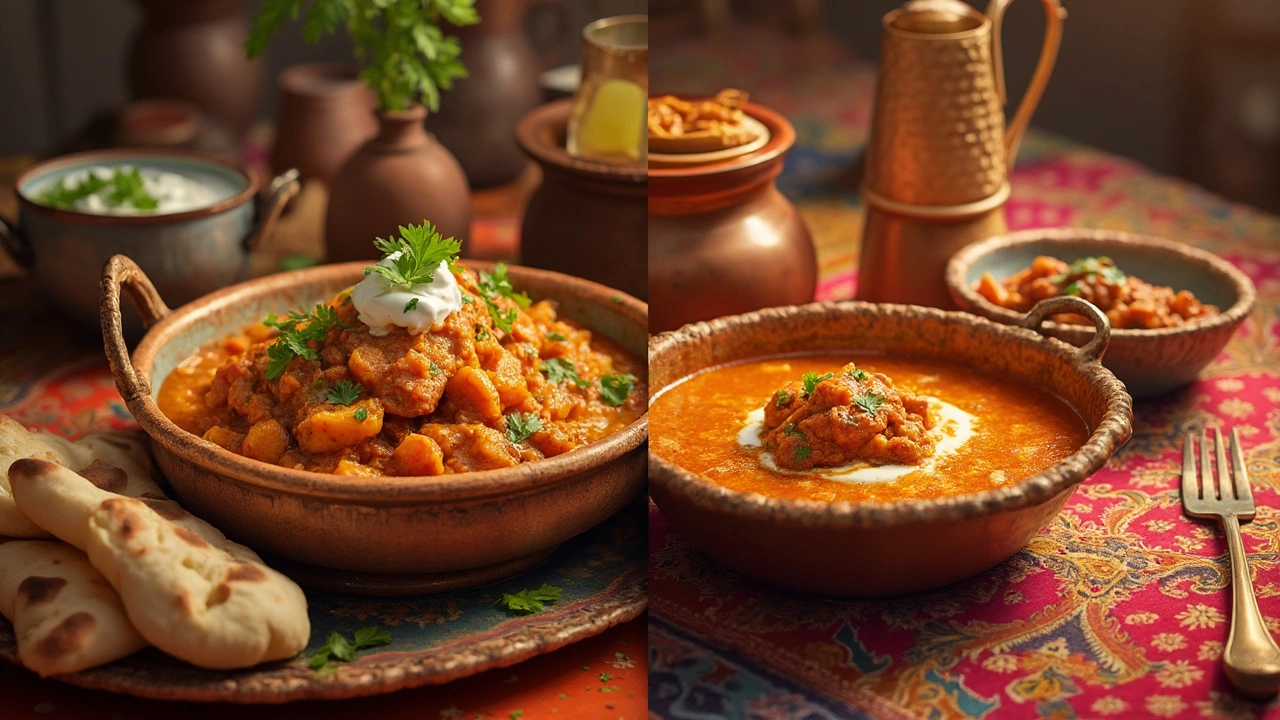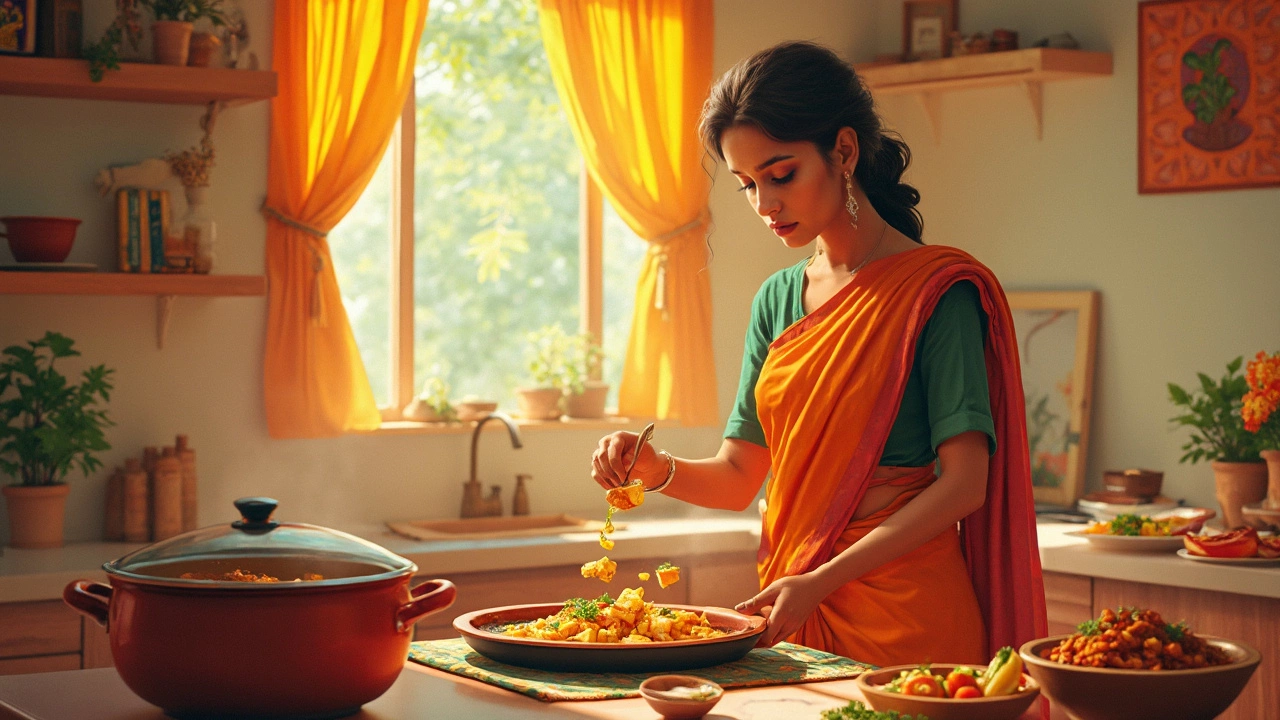People toss around the word "curry" for almost any saucy Indian dish, but is that really fair to tikka masala? Next time you're staring at a menu, you might wonder: isn’t tikka masala just another type of curry? The answer depends on what you call a curry and how honest Indian food menus are where you live.
At first glance, both curry and tikka masala look like tomato-based, spice-filled gravies, and they both go great with fluffy rice or naan. But here’s the thing—tikka masala always starts with tikka, which means pieces of grilled or roasted vegetables (or paneer, if you go vegetarian), dunked in that creamy, rich sauce. Curries, on the other hand, have a broader meaning. The typical curry can be thin or thick, smooth or chunky, with almost anything from potatoes to chickpeas to eggplant tossed in, usually cooked straight in the sauce, not grilled on the side.
If you’ve ever tried to make both at home, you already know this: prepping tikka masala means marinating and grilling those veggies for extra flavor. Curries don't always ask this of you—sometimes, you just throw your veg into a spicy gravy and simmer. So if you love shortcuts, curries are your best friend. But if you like smoky, bold bites, that classic char on your tikka makes tikka masala feel extra special.
- What Makes Something a Curry?
- How Tikka Masala Stands Out
- Vegetarian Tikka Masala vs. Veg Curries
- Tips for Cooking Both at Home
What Makes Something a Curry?
Ready to bust the myth? Not every saucy dish from India is a curry. The actual word “curry” comes from the Tamil word “kari,” which just means sauce. In the West, people call all sorts of Indian stews and gravies “curries,” whether they're loaded with veggies, paneer, or beans. But in Indian kitchens, curry means something much more specific than ‘any random spicy dish.’
So, what should really go into a proper curry? There are a few must-haves:
- Spice mix (masala): Most curries start with onions, garlic, ginger, and a mix of ground spices such as turmeric, cumin, coriander, and chili.
- Liquid: Water, stock, coconut milk, or yogurt makes it saucy. Some curries are soupy, some are thick.
- Base veggies or protein: Anything from potatoes and peas to chickpeas or paneer. The sauce cooks around them as everything blends together.
Here's a tip you won't find on a menu: in North India, a curry is often called “sabzi” or “sabji” when it’s dry, and “gravy” when it’s wetter. In South India, dishes like “sambar” (a lentil curry) or “kootu” have their own unique twists—sometimes even with coconut or tamarind. There's no single curry formula across regions, so “curry” is really a family of dishes, not one exact thing.
Check out how varied they can be:
| Type | Main Liquid | Common Veggies |
|---|---|---|
| North Indian Curry | Tomato, onions, yogurt | Cauliflower, potatoes, peas |
| South Indian Curry | Coconut milk, tamarind, sambar | Eggplant, drumstick, okra |
| Gujarati Curry (Kadhi) | Yogurt, chickpea flour | Papdi, potatoes |
The defining thing about a vegetarian Indian curry? The veggies or paneer cook right in the gravy, soaking up flavor as they simmer. With curry dishes, it’s all about slow, even cooking so everything absorbs that spiced sauce. No grilled bits, no charring—just soft, homely comfort food that smells amazing.
How Tikka Masala Stands Out
Let’s get straight to it: tikka masala isn’t just sauce and spices thrown together. What really makes it unique among vegetarian Indian dishes is the way the star ingredient—usually paneer or firm vegetables—gets prepped. You marinate those chunks in yogurt, ginger, garlic, and a mix of spices, then grill or roast them separately before dropping them into that velvety tomato-based sauce. This grilling step is what gives tikka masala its smoky flavor and that slightly charred bite you can't mimic just by simmering veggies in gravy.
And here’s a fact that surprises a lot of people: tikka masala’s sauce is way creamier than your average curry. It’s all about that base made with tomatoes, cream (or cashew paste if you want a vegan twist), garam masala, and a hint of sugar. The sauce isn’t meant to be watery—it’s rich and sticks to each piece of tikka like glue.
When you walk into an Indian restaurant outside India, half the time their best-selling dish is tikka masala. Some kitchen surveys in the UK even show that more than 20% of vegetarian Indian takeout orders include some version of paneer tikka masala. People love that balance of tangy, sweet, and smoky flavors—it just hits different compared to basic curries.
If you’re keeping an eye out on texture, tikka masala usually serves chunky pieces, while other curries can end up soft and almost soup-like. Here’s a quick side-by-side to make it extra clear:
| Tikka Masala | Veg Curries | |
|---|---|---|
| Main ingredient prep | Grilled or roasted before going in sauce | Straight to gravy, no grilling |
| Sauce style | Thick, creamy, smoky | Can be thick or thin, less creamy |
| Texture | Chunky, pieces hold shape | Veggies are usually softer |
So, the next time you think all curries are the same, just remember: nothing beats that first bite of smoky, marinated, and perfectly sauced tikka masala.

Vegetarian Tikka Masala vs. Veg Curries
The real difference between tikka masala and regular veg curries comes down to both the cooking method and the starring ingredients. For tikka masala, the word "tikka" isn’t just for show—it means you start by marinating bite-sized chunks, usually paneer, cauliflower, or mushrooms, in a spiced yogurt mix. Then you roast or grill these chunks before dropping them into the sauce. This step gives tikka masala its signature flavor and those little burnt edges everyone loves.
Now, compare that to a classic veg curry. Curries are a whole category, not just one dish. The veggies (like potatoes, peas, carrots, or even lentils) are usually cut up and cooked directly in a spicy gravy. There’s no marinating, no grilling, just the honest, straightforward method of simmering all the flavors together. Some curries use coconut milk for creaminess, while others stay tomato-based or use just water and spices.
Check out the key differences:
- Tikka masala: Always features marinated and roasted chunks (like paneer tikka, cauliflower tikka), rich creamy sauce, mild to medium spice.
- Veg curries: Broad category, no marinating, vegetables simmered in sauce, spice levels can swing mild to fiery.
And here’s a practical nugget—if you’re eating out and the menu lists “paneer tikka masala,” you should expect paneer that’s been grilled before drowning in sauce. If it just says “paneer curry,” it’s probably softer cubes simmered from the start in a plain gravy, missing that smoky edge.
For those who like numbers, data from a 2023 restaurant survey in India and the UK showed that tikka masala is one of the top three most-ordered vegetarian Indian dishes, while mixed veg curry usually ranks fifth or sixth. People seem to crave that extra bite from the grilled veggies.
| Dish | Cooking Method | Main Ingredient(s) | Texture |
|---|---|---|---|
| Vegetarian Tikka Masala | Grilled, then simmered in sauce | Paneer, Cauliflower, Mushroom | Firm, slightly charred |
| Mixed Veg Curry | Simmered in gravy | Potato, Peas, Carrot, Beans | Soft, saucy |
This extra step of roasting or grilling isn’t just a detail—it makes tikka masala a flavor bomb. Even if both dishes use the same Indian food tips for seasoning, the results taste completely different. So, no, tikka masala isn’t just another curry—it’s in a league of its own among vegetarian Indian dishes.
Tips for Cooking Both at Home
Want to make tikka masala or curry at home? It doesn’t have to feel tricky or expensive. Here’s how to pull it off, even if you don’t have a tandoor oven or a pile of spices from the market.
If you’re going for classic vegetarian tikka masala, start with marinating your paneer, tofu, or hearty veggies (like cauliflower or bell peppers) in yogurt, a pinch of chili powder, turmeric, salt, and garam masala. Let it sit for at least 30 minutes—overnight is even better. After marinating, roast or grill the pieces. An oven broiler works fine if you don’t have a grill. That char is the secret sauce. Then, make your creamy gravy by sautéing onions and garlic, adding diced tomatoes or even tomato puree, and a splash of cream or coconut milk. Stir in your roasted veggies or paneer, simmer, and taste for salt and spice.
For a simple vegetarian curry, skip the marinating and grilling. Just toss your vegetables—potatoes, carrots, peas, whatever you like—right into a hot pan with oil and cumin seeds. Add chopped onions, garlic, ginger, and a shake of basic curry powder or turmeric, coriander, and chili. Pour in diced tomatoes and a little water for a thinner sauce. Let it all cook together until tender. Curries are forgiving, so don’t stress exact steps—just taste as you go.
- If you’re new to Indian food, buy pre-blended curry powder and garam masala at the grocery store. No shame—it's practical and works fine.
- Batch-cook your sauce and freeze extra portions. Both dishes taste even better reheated.
- If dairy isn’t your thing, swap yogurt for plant-based yogurt and cream for coconut milk.
- Add a pinch of sugar at the end if your tomatoes taste too sour.
- Don’t forget a squeeze of lemon or sprinkle of fresh cilantro before serving to brighten flavors.
Many people wonder how long these dishes last. At regular fridge temps (under 40°F/4°C), both tikka masala and curry stay fresh for up to 3 days. If you freeze them right after cooking, they’ll hold up for 2 months without losing flavor.
| Dish | Prep Time | Cook Time |
|---|---|---|
| Vegetarian Tikka Masala | 1 hr (including marinate) | 25 mins |
| Veg Curry | 10 mins | 20 mins |
Don’t forget—practice is key. The more you cook these, the better you’ll get at adjusting flavor, spice, and texture. Enjoy the process and don’t stress if it isn’t restaurant-perfect the first time.
